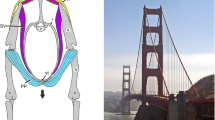Abstract
In order to refine the concept of brachiation as a locomotor mode and to examine the complex relationship between locomotor behavior and muscle morphology, we have undertaken a telemetered electromyographic (EMG) analysis of muscle recruitment in brachiating gibbons (Hylobates lar) and spider monkeys (Ateles belzebuth andAteles fusciceps) Electrical activity patterns were determined for both support and swing phases in the following muscles: cranial pectoralis major, caudal pectoralis major, middle deltoideus, short head of biceps brachii, flexor digitorum superficialis, latissimus dorsi, and dorsoepitrochlearis. Our experimental findings reinforce earlier behavioral observations that brachiation is not a discrete, stereotyped locomotor activity. EMG patterns differed most between gibbon and spider monkey in those muscles that exhibit markedly disparate morphologies in the two genera-pectoralis major (both portions) and the short head of biceps brachii. Additional recruitment differences appear related to consistent species-specific differences in the timing and mechanics of both support and swing phases, and probably to the role of the prehensile tail as a fail-safe mechanism in the spider monkey.
Similar content being viewed by others
References
Ashton, E. H., and Oxnard, C. E. (1963). The musculature of the primate shoulder.Trans. Zool. Soc. Lond. 29: 553–650.
Andrews, P., and Groves, C. P. (1976). Gibbons and brachiation.Gibbon Siamang 4: 167–218.
Avis, V. (1962). Brachiation: The crucial issue for man’s ancestry.Southwest. J. Anthropol. 18: 119–148.
Campbell, B. (1937). The shoulder musculature of the platyrrhine monkeys.J. Mammal. 18: 66–71.
Carpenter, C. R. (1940). A field study in Siam of the behavioral and social relationships of the gibbon (Hylobates lar).Comp. Psyehol. Monogr. 16(5): 1–212.
Carpenter, C. R. (1976). Suspensory behavior of gibbons,Hylobates lar. A photoessay.Gibbon Siamang 4: 1–20.
Carpenter, C. R., and Durham, N. M. (1969). A preliminary description of suspensory behavior in non-human primates.Proce. 2nd Int. Congr. Primatol., Atlanta, Vol. 2, Karger, Basel, pp. 147–154.
Donisch, E. (1973). A comparative study of the back muscles of gibbon and man.Gibbon Siamang. 2: 96–120.
Engberg, I., and Lundberg, A. (1969). An electromyographic analysis of muscular activity in the hindlimb of the cat during unrestrained locomotion.Acta Physiol. Scand. 75: 615–630.
Fleagle, J. G. (1974). The dynamics of a brachiating siamang (Hylobates (Symphalangus) syndactylus).Nature 248: 259–260.
Fleagle, J. G. (1977). Brachiation and biomechanics: The siamang as example.Malay Nat. J. 30:45–51.
Fleagle, J. G., Stern, J. T., Jr., Jungers, W. L., Susman, R. L., Vangor, A. K., and Wells, J. P. (1981). Climbing: A biomechanical link with brachiation and bipedalism. In Day, M. H. (ed.),Vertebrate Locomotion, Symp. Zool. Soc. Lond., Academic Press, London. 33
Grönroos, H. (1903). Die Musculi biceps brachii und latissimo-condyloideus bei der AffengattungHylobates im Vergleich mit den entsprechenden Gebilden der Anthropoiden und des Menschen.Abh. K. Preuss. Akad. Wiss. Berl. 1903: 1–102.
Howell, A. B., and Straus, W. L. (1931). The brachial flexor muscles in primates.Proc. U.S. Natl. Mus. 80: 1–30.
Inman, V. T., Saunders, M., and Abort, L. C. (1944). Observations on the function of the shoulder joint.J. Bone Joint Surg. 26: 1–30.
Jenkins, F. A., Jr., Dombrowski, P. J., and Gordon, E. P. (1978). Analysis of the shoulder in brachiating spider monkeys.Am. J. Phys. Anthropol. 48: 65–76.
Jungers, W. L., and Stern, J. T., Jr. (1980). Telemetered electromyography of forelimb muscle chains in gibbons (Hylobates lar).Science 208: 617–619.
Jungers, W. L., Jouffroy, F. K., and Stern, J. T., Jr. (1980). Gross structure and function of the quadriceps femoris inLemur fulvus: An analysis based on telemetered electromyography.J. Morphol. 164: 287–299.
KohlbrŪgge, J. H. F. (1890).Muskeln und periphere Nerven des GenusHylobates, E. J. Brill, Leiden.
Kummer, B. (1970). Die Beanspruchung des Armskeletts beim Hangeln. Eim Beitrag zum Brachiatorenproblem.Anthropol. Anz. 32: 74–82.
Lewis, O. J. (1969). The hominoid wrist joint.Am J. Phys. Anthropol. 30: 251–268.
Lewis, O. J. (1971). The contrasting morphology found in the wrist joint of semibrachiating monkeys and brachiating apes.Folia Primatol. 16: 248–256.
Mittermeier, R. A. (1978). Locomotion and posture inAteles geoffroyi andAteles paniscus Folia Primatol. 30: 161–193.
Mittermeier, R. A., and Fleagle, J. G. (1976). The locomotor and postural repertoires ofAteles geoffroyi andColobus guereza, and a re-evaluation of the locomotor category semibrachiation.Am. J. Phys. Anthropol. 45: 236–251.
Napier, J. (1963). Brachiation and brachiators.Symp. Zool Soc. Lond. 10: 183–194.
Norman, R. W., and Komi, P. V. (1979). Electromechanical delay in skeletal muscle under normal movement conditions.Acta Physiol. Scand. 106: 241–248.
Stern, J. T., Jr., and Oxnard, C. E. (1973). Primate locomotion: Some links with evolution and morphology.Primatologia 4 (If. 11): 1–93.
Stern, J. T., Jr., Wells, J. P., Vangor, A. K., and Fleagle, J. G. (1977). Electromyography of some muscles of the upper limb inAteles andLagothrix.Yrbk. Phys. Anthropol. 20: 498–507.
Stern, J. T., Jr., Wells, J. P., Jungers, W. L., Vangor, A. K., and Fleagle, J. G. (1980). An electromyographic study of the pectoralis major in atelines andHylobates, with special reference to the evolution of a pars clavicularis.Am. J. Phys. Anthropol. 52: 13–25.
Susman, R. L., and Stern, J. T., Jr. (1979). Telemetered electromyography of flexor digitorum profundus and flexor digitorum superficialis inPan troglodytes and implications for interpretation of the O. H. 7 hand.Am. J. Phys. Anthropol. 50: 565–574.
Trevor, J. C. (1963). The history of the word “brachiator” and a problem of authorship in primate nomenclature.Symp. Zool. Soc. Lond. 10: 197–198.
Tuttle, R. H. (1968). Does the gibbon swing like a pendulum?Am. J. Phys. Anthropol. 29: 132 (abstract).
Tuttle, R. H. (1972). Functional and evolutionary biology of hylobatid hands and feet.Gibbon Siamang 1: 136–206.
Tuttle, R. H. (1975). Parallelism, brachiation, and hominoid phylogeny. In Luckett, W. P., Szalay, F. S. (eds.),Phylogeny of the Primates, Plenum Press, New York, pp. 447–480.
Author information
Authors and Affiliations
Rights and permissions
About this article
Cite this article
Jungers, W.L., Stern, J.T. Preliminary electromyographical analysis of brachiation in gibbon and spider monkey. Int J Primatol 2, 19–33 (1981). https://doi.org/10.1007/BF02692297
Received:
Revised:
Issue Date:
DOI: https://doi.org/10.1007/BF02692297




